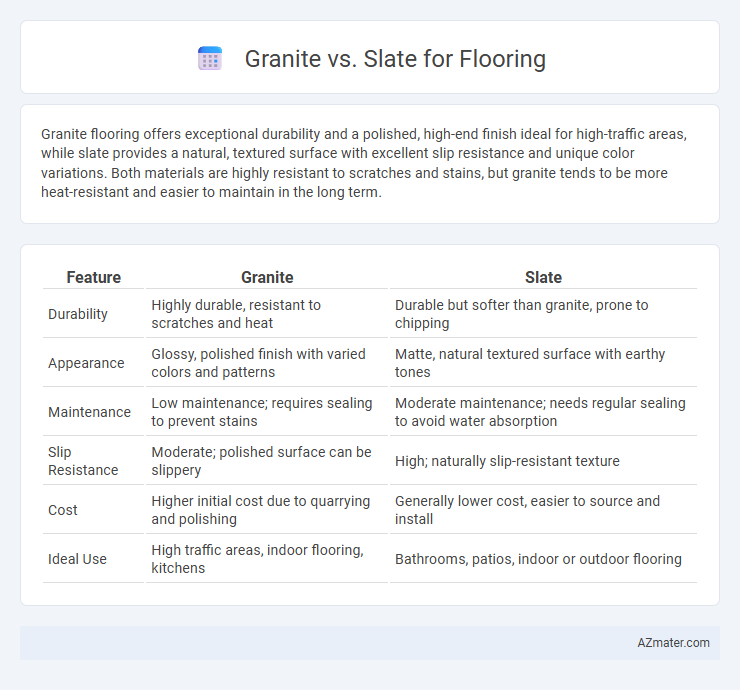Granite flooring offers exceptional durability and a polished, high-end finish ideal for high-traffic areas, while slate provides a natural, textured surface with excellent slip resistance and unique color variations. Both materials are highly resistant to scratches and stains, but granite tends to be more heat-resistant and easier to maintain in the long term.
Table of Comparison
| Feature | Granite | Slate |
|---|---|---|
| Durability | Highly durable, resistant to scratches and heat | Durable but softer than granite, prone to chipping |
| Appearance | Glossy, polished finish with varied colors and patterns | Matte, natural textured surface with earthy tones |
| Maintenance | Low maintenance; requires sealing to prevent stains | Moderate maintenance; needs regular sealing to avoid water absorption |
| Slip Resistance | Moderate; polished surface can be slippery | High; naturally slip-resistant texture |
| Cost | Higher initial cost due to quarrying and polishing | Generally lower cost, easier to source and install |
| Ideal Use | High traffic areas, indoor flooring, kitchens | Bathrooms, patios, indoor or outdoor flooring |
Introduction to Granite and Slate Flooring
Granite flooring offers exceptional durability and a unique, polished appearance due to its natural crystalline structure, making it ideal for high-traffic areas. Slate flooring provides a textured, slip-resistant surface with natural cleavage planes, adding a rustic and sophisticated aesthetic to interiors. Both materials are natural stones renowned for their longevity and distinctive visual appeal but differ significantly in maintenance requirements and surface finish.
Key Differences Between Granite and Slate
Granite flooring offers exceptional durability and a polished, glossy finish with a wide array of color variations, while slate provides a natural, textured surface that enhances slip resistance and presents earthy tones. Granite is an igneous rock formed from cooled magma, known for its hardness and resistance to scratches and stains, whereas slate is a metamorphic rock composed of clay minerals, valued for its layered structure and water resistance. Maintenance requirements differ as granite needs regular sealing to maintain its shine, while slate requires sealing to prevent moisture absorption and preserve its rugged appearance.
Appearance and Aesthetic Appeal
Granite flooring offers a polished, glossy surface with natural variations in color and pattern, providing a luxurious and timeless aesthetic that suits both traditional and modern interiors. Slate flooring features a more textured, matte finish with earthy tones and a natural cleft surface that adds rustic charm and visual depth to spaces. The choice between granite and slate largely depends on desired ambiance, with granite emphasizing elegance and durability, while slate emphasizes natural, rugged beauty.
Durability and Longevity Comparison
Granite offers exceptional durability due to its dense composition and high resistance to scratches, stains, and heavy foot traffic, making it ideal for long-lasting flooring solutions. Slate, while also durable and resistant to chips and cracks, is softer than granite and may require more maintenance to prevent surface wear over time. Both stones provide excellent longevity, but granite's hardness and low porosity give it a superior edge for enduring high-impact environments with minimal degradation.
Maintenance and Cleaning Requirements
Granite flooring requires minimal maintenance due to its high resistance to stains and scratches, needing only regular sweeping and occasional sealing to preserve its polished surface. Slate demands more frequent cleaning and sealing because of its porous nature, which makes it more susceptible to water absorption and stains if untreated. Both materials benefit from pH-neutral cleaners, but granite's durability reduces the intensity and frequency of cleaning compared to slate.
Slip Resistance and Safety Factors
Granite offers moderate slip resistance with its naturally rough texture, making it a safer choice for high-traffic indoor flooring but may become slippery when polished or wet. Slate provides superior slip resistance due to its cleft surface, enhancing safety in wet or humid environments such as bathrooms and kitchens. Choosing between granite and slate for flooring should prioritize slip resistance based on usage area and maintenance conditions to prevent falls and ensure optimal safety.
Installation Process and Costs
Granite flooring installation involves skilled labor for precise cutting and anchoring, with costs ranging from $40 to $100 per square foot, reflecting its durability and high-end appeal. Slate flooring requires less intensive cutting but demands proper underlayment to prevent cracking, generally costing between $30 and $60 per square foot. Both materials require professional installation to ensure longevity, but granite tends to incur higher labor and material expenses due to its hardness.
Environmental Impact and Sustainability
Granite flooring offers high durability and long lifespan, reducing the need for frequent replacements and minimizing environmental waste, but its extraction involves energy-intensive quarrying that can disrupt local ecosystems. Slate is a natural, recyclable material with a lower carbon footprint in processing compared to granite, often sourced from smaller-scale quarries that prioritize sustainable practices. Both stones are environmentally friendly options when sourced responsibly, but slate's lower energy use and recyclability make it slightly more sustainable for eco-conscious flooring projects.
Best Applications for Granite vs Slate Flooring
Granite flooring excels in high-traffic commercial spaces and kitchens due to its exceptional hardness and resistance to scratches and stains. Slate flooring is ideal for outdoor patios, bathrooms, and rustic interiors because of its natural slip resistance and moisture durability. Both materials offer distinct aesthetic appeal, with granite providing a polished, elegant finish and slate showcasing a textured, earthy look suitable for traditional designs.
Choosing the Right Stone for Your Home
Granite offers exceptional durability and resistance to scratches and heat, making it ideal for high-traffic areas and kitchens, while slate provides a unique, textured surface with natural slip resistance, suitable for bathrooms and outdoor spaces. Granite's wide range of colors and polished finish enhances modern aesthetics, whereas slate's earthy tones and matte look complement rustic or traditional interiors. Selecting between granite and slate depends on your home's style, functional needs, and maintenance preferences, ensuring the flooring material aligns with both durability requirements and design goals.

Infographic: Granite vs Slate for Flooring
 azmater.com
azmater.com